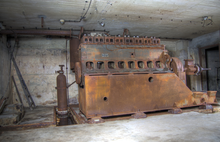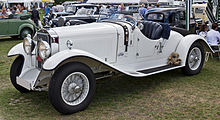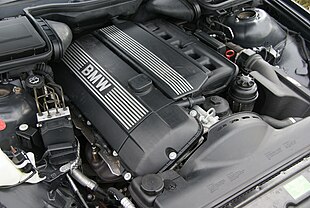In-line engine
In-line engine is the designation of the design of a reciprocating piston engine , the cylinders of which are in a row. In-line engines are by far the most common type of internal combustion engine used in cars, trucks, and motorcycles. The smallest form the parallel twin - two-cylinder engine ; as a marine diesel engine (e.g. Wärtsilä RT-flex96C ) there are versions with up to 14 cylinders.
variants

Four-cylinder in-line engines are most commonly used. Three and six cylinders are also common, whereas the five cylinders are rare. Because of their large overall length, eight-cylinder engines are less common (see also disadvantages ). Marine diesel engines are also available as in-line engines with seven , nine and eleven cylinders and with higher uneven numbers of cylinders.
Mounting position
The installation position must be distinguished from the design, since reciprocating piston engines can basically be installed as required. However, the crankshaft bearings , carburetor / injection and engine lubrication must be adjusted accordingly. Traditionally, a distinction is made between standing, lying and hanging installation, whereby the designation refers to the position of the cylinder or the cylinder head . With engines installed “vertically”, the crankshaft is at the bottom and the cylinders point upwards; When installed horizontally, the cylinder and crankshaft are at the same height; if the crankshaft is at the top and the cylinder head is at the bottom, it is an engine with "hanging" cylinders.
The latter type occurs almost exclusively in historical aircraft. The landing gear can be designed less high for a given propeller diameter, and the view of the pilot is less obstructed by exhaust gases. In addition, the center of gravity is lower and the accessibility of the cylinder head ( valve control ) and spark plugs is easier. Air-cooled in -line four-cylinder engines with hanging cylinders were e.g. B. the Zündapp 9-092 and the Hirth HM 515 .
In particular, engines with OHC valve control have a greater overall height due to the overhead camshaft (s) and are often installed at an angle as transverse and longitudinal engines in order to keep the bonnet flatter. Motors installed horizontally are often used as underfloor motors in trucks, buses and railcars.
Cylinder count
In the case of vehicle engines, the cylinder count begins opposite the power output side, i.e. opposite the flywheel or the clutch . This does not apply to German ship and stationary engines . However, there are Japanese and French manufacturers who are also starting to count on the clutch side.
use
Six-cylinder in-line engines are usually found in trucks, while smaller trucks sometimes only have four cylinders. Two and four cylinders, more rarely three and very rarely six cylinders ( Benelli 750 Sei , Honda CBX , Kawasaki Z 1300 , BMW K 1600 GT ) are usually used for motorcycles .
In-line engines are installed lengthways in rear-wheel drive automobiles with a front engine , and also transversely in mid- engine or rear-engine vehicles. With front-wheel drive , they are usually installed transversely, sometimes also lengthways, which, however, causes increased effort in the vehicle or differential gear . Transverse installation predominates in motorcycles. In the early days there were motorcycles with longitudinally installed in-line engines from, among others, Indian , Windhoff and Nimbus ; more recently with the BMW K series ( K 1 to K 1200 RS ) and currently with the Triumph Rocket III . In-line engines are practically always installed lengthways in trucks.
Inline eight-cylinder




Probably the first engine of this type produced the Daimler-Motoren-Gesellschaft (DMG) in 1897 for the airship Germany by Friedrich Hermann Wölfert . In 1902, the French manufacturer CGV designed the first eight-cylinder in-line engine for an automobile. This racing engine had a displacement of 7.2 liters and standing valves on both sides of the cylinders ( T-head engine ). This was followed in 1903 Premier (USA), 1904 Bellamy (France), Dufaux (Switzerland) and the Winton Bullett-2 racing car (USA), 1906 Maxwell-Briscoe (USA) with a Vanderbilt Cup racing car and 1907 Porthos (France) , Weigel (United Kingdom) and again Dufaux. The Florentia boat engine, which Émile Mathis sold among others, is documented as early as 1906 , and in 1907 Wolseley-Siddeley produced such an engine with already 200 hp (147 kW) for the Ursula racing boat ; a further development was used in 1910 in the first British rigid airship . In the same year, the Green overhead camshaft aircraft engine appeared . In 1911 DMG brought out the Mercedes J8L airship engine .
The first production car with such an engine was the Isotta Fraschini Tipo 8 ; the engine was developed in 1912, used successfully in the Tipo V5 racing car with an overhead camshaft and went into series production in 1919. Ettore Bugatti experimented 1913–1914 with an eight-cylinder block engine , which consisted of two four-cylinder blocks with a flywheel in between. Many Bugatti automobiles, starting with the Type 30 , had in-line eight-cylinders. The largest of these - used in the Type 41 "Royale" - is one of the largest car engines ever built with a displacement of 14.7 liters (later 12.7 liters); up to four of them were installed in the Bugatti multiple unit (type XB 1000 of the French railways SNCF ).
In the 1920s and 1930s, German manufacturers also offered cars with inline eight-cylinder engines, starting with the Horch 8 presented in 1926 by the Horchwerke in Zwickau , the successor of which, 850/951, was built until 1940. The Rohr Auto AG in Ober-Ramstadt 1927 put the Röhr 8 before. In 1928, Opel had a vehicle with an in-line eight-cylinder engine on offer for a short time with the 24/110 hp “Regent”. Most of the eight-cylinder cars were in the Daimler-Benz range : in autumn 1928 the Nürburg 460/460 K (later the Nürburg 500/500 N ; until 1939) came onto the market, followed in 1930 by the “Great Mercedes” type 770 , which was known as the W 150 was built until 1943. In addition, there were the models ( Mannheim ) 380 S (1932/33), 380/380 K (1933/34), 500 K / 540 K (1934 to 1939) and, in small numbers, the G4 off-road vehicles .
From 1953 to 1955, the Mercedes-Benz racing department used the W 196 racing car in Formula 1 , which was powered by a 2.5-liter eight-cylinder in-line engine with an output of up to 280 hp (206 kW).
Buick relied exclusively on this type of engine for over two decades, starting in 1931 with the Series 80 and Series 90 (from 1936 "Roadmaster" or "Limited") up to the Roadmaster Series 70 of 1952. In 1954, the US manufacturers Packard and Pontiac were the last mass manufacturers to stop building eight-cylinder in-line engines for passenger cars. On December 11, 1956, Rolls-Royce delivered the last Phantom IV , which had an eight-cylinder in-line engine with 6516 cm³, to the Shah Reza Pahlevi - and thus probably the last eight-cylinder in-line car of all time.
advantages
- easy construction
- small width
- In four-stroke engines with six cylinders (six-cylinder in-line, R6) or more (even number of cylinders) and a longitudinally symmetrical crankshaft, all first and second-order forces and torques are dynamically balanced.
- relatively inexpensive to produce
- Can also be easily implemented with air cooling
- On the basis of a basic construction, variants with different numbers of cylinders are possible (see Deutz 912 or Wärtsilä RT-flex96C ) - modularization of cylinders and cylinder heads ( Deutz- typical design)
disadvantage
- high space requirement in length with more than four cylinders
- with six or more cylinders, the torsional vibrations of the crankshaft are more difficult to control
- In the case of air-cooled, longitudinally installed engines, there may be cooling problems on the rear cylinders
- In the very common in-line four-cylinder four-stroke engines, the free inertia forces of the second order are not balanced. On the other hand, a Lanchester compensation can be used.
A disadvantage of a longitudinal installation is the fact that the moment of inertia of the crankshaft and flywheel causes the vehicle to roll when the load changes . This noticeably worsens driving comfort and has a more disruptive effect than the pitching moment around the transverse axis that occurs during transverse installation when the load changes.
literature
- Jan Drummans: The car and its technology. 1st edition. Motorbuchverlag, Stuttgart 1992, ISBN 3-613-01288-X .
- Peter Gerigk, Detlev Bruhn, Dietmar Danner: Automotive engineering. 3. Edition. Westermann Schulbuchverlag, Braunschweig 2000, ISBN 3-14-221500-X .
- Griffith Borgeson: Bugatti by Borgeson - The dynamics of mythology. Osprey Publishing, London 1981, ISBN 0-85045-414-X . (English)
Web links
- Interactive in-line engine
- About the smoothness of various engine concepts
- Mass balancing and smoothness of reciprocating engines (animated)
